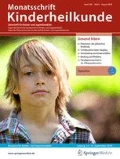Zusammenfassung
Die perinatale Adaptation ist ein komplexer Prozess, in dessen Mittelpunkt das Einsetzen der Atmung mit der damit verbundenen Entfernung von Flüssigkeit aus den Atemwegen und die Umstellung des fetalen Kreislaufs stehen. Unmittelbar nach der Geburt ergibt sich selten der Bedarf einer Wiederbelebung (Reanimation); vielmehr machen Störungen der Adaptation häufiger eine medizinische Unterstützung (Animation) unterschiedlichen Ausmaßes erforderlich. Ziel der vorliegenden Arbeit ist ein Überblick über aktuelle Empfehlungen, wie potenzielle Probleme der postnatalen Adaptation vermieden und klinische Symptome der gestörten Adaptation erkannt bzw. behandelt werden können. Dabei wird auch auf Besonderheiten der aktuellen Empfehlungen des European Resuscitation Council (ERC) eingegangen.
Abstract
Perinatal transition represents a complex process, including onset of breathing which is associated with a clearance of lung fluid and the hemodynamic changes from fetal circulation. Whereas disturbances in postnatal adaptation with a subsequent need for medical support of varying intensity are relatively frequent immediately after parturition, only few infants actually require resuscitation. This article gives an overview of current recommendations on how to prevent problems in adaptation and how to diagnose and treat symptoms of disturbed adaptation. It also covers some special aspects of the current guidelines of the European Resuscitation Council (ERC).
Literatur
Al-Wassia H, Shah PS (2015) Efficacy and safety of umbilical cord milking at birth: a systematic review and meta-analysis. JAMA Pediatr 169:18–25. doi:10.1001/jamapediatrics.2014.1906
Apgar V (1953) A proposal for a new method of evaluation of the newborn infant. Curr Res Anesth Analg 32:260–267
Bradshaw LE, Pushpa-Rajah A, Dorling J et al (2015) Cord pilot trial: update to randomised trial protocol. Trials 16:1–3. doi:10.1186/s13063-015-0936-2
Chaillet N, Dumont A, Abrahamowicz M et al (2015) A cluster-randomized trial to reduce cesarean delivery rates in quebec. N Engl J Med 372:1710–1721. doi:10.1056/NEJMoa1407120
Dalili H, Nili F, Sheikh M et al (2015) Comparison of the four proposed Apgar scoring systems in the assessment of birth asphyxia and adverse early neurologic outcomes. PLoS ONE doi:10.1371/journal.pone.0122116
Dalili H, Sheikh M, Hardani AK et al (2016) Comparison of the combined versus conventional Apgar scores in predicting adverse neonatal outcomes. PLoS ONE 11:e0149464 doi:10.1371/journal.pone.0149464
a DJ, Kamlin COF, Vento M et al (2010) Defining the reference range for oxygen saturation for infants after birth. Pediatrics 125:e1340–e1347. doi:10.1542/peds.2009–1510
Feldman R, Weller A, Sirota L, Eidelman AI (2002) Skin-to-skin contact (kangaroo care) promotes self-regulation in premature infants: sleep-wake cyclicity, arousal modulation, and sustained exploration. Dev Psychol 38:194–207. doi:10.1037/0012-1649.38.2.194
Gyamfi-Bannerman C, Thom EA, Blackwell SC et al (2016) Antenatal betamethasone for women at risk for late preterm delivery. N Engl J Med 374. doi:10.1056/NEJMoa1516783
Hooper SB, Pas AB te, Lang J et al (2015) Cardiovascular transition at birth: a physiological sequence. Pediatr Res 77:608–614. doi:10.1038/pr.2015.21
Kennell J, McGrath S (2005) Starting the process of mother-infant bonding. Acta Paediatr 94:775–777. doi:10.1080/08035250510035634
Mehler K, Wendrich D, Kissgen R et al (2011) Mothers seeing their VLBW infants within 3 h after birth are more likely to establish a secure attachment behavior: evidence of a sensitive period with preterm infants? J Perinatol 31:404–410. doi:10.1038/jp.2010.139
Mikiel-Kostyra K, Mazur J, Boltruszko I (2007) Effect of early skin-to-skin contact after delivery on duration of breastfeeding: a prospective cohort study. Acta Paediatr 91:1301–1306. doi:10.1111/j.1651-2227.2002.tb02824.x
Miserocchi G, Haxhiu B, Fabbro M del (1994) Pulmonary interstitial newborn rabbits pressure in anesthetized paralyzed. J Appl Physiol 77:2260–2268
Phillipos E, Solevåg AL, Pichler G et al (2015) Heart rate assessment immediately after birth. Neonatology 9:130–138. doi:10.1159/000441940
Pinheiro JM (2009) The Apgar cycle: a new view of a familiar scoring system. Arch Dis Child Fetal Neonatal Ed 94:F70–F72. doi:10.1136/adc.2008.145037
Rabe H, Diaz-Rossello JL, Duley L, Dowswell T (2012) Effect of timing of umbilical cord clamping and other strategies to influence placental transfusion at preterm birth on maternal and infant outcomes. Cochrane Database Syst Rev 8:CD003248. doi:10.1002/14651858.CD003248.pub3
Rüdiger M, Braun N, Aranda J et al (2015) Neonatal assessment in the delivery room – trial to evaluate a specified type of Apgar (TEST-Apgar). BMC Pediatr 15:18. doi:10.1186/s12887-015-0334-7
Rüdiger M, Wauer RR, Schmidt K, Küster H (2006) The Apgar score. Pediatrics 118:1314–1315 (author reply 1315–1316). doi:10.1542/peds.2006–1254
Schmid MB, Reister F, Mayer B et al (2013) Prospective risk factor monitoring reduces intracranial hemorrhage rates in preterm infants. Dtsch Arztebl Int 110:489–496. doi:10.3238/arztebl.2013.0489
Smit M, Dawson JA, Ganzeboom A et al (2014) Pulse oximetry in newborns with delayed cord clamping and immediate skin-to-skin contact. Arch Dis Child Fetal Neonatal Ed 99:F309–F314. doi:10.1136/archdischild-2013-305484
Statement P (2006) The Apgar score. Pediatrics 117:1444–1447. doi:10.1542/peds.2006-0325
Stutchfield P, Whitaker R, Russell I (2005) Antenatal betamethasone and incidence of neonatal respiratory distress after elective caesarean section: pragmatic randomised trial. BMJ 331:660–662. doi:10.1136/bmj.38547.416493.06
Stutchfield PR, Whitaker R, Gliddon AE et al (2013) Behavioural, educational and respiratory outcomes of antenatal betamethasone for term caesarean section (ASTECS trial). Arch Dis Child Fetal Neonatal Ed 98:F195–F200. doi:10.1136/archdischild-2012-303157
Wyllie J, Bruinenberg J, Roehr CC et al (2015) European resuscitation council guidelines for resuscitation 2015. Resuscitation 95:249–263. doi:10.1016/j.resuscitation.2015.07.029
Author information
Authors and Affiliations
Corresponding author
Ethics declarations
Interessenkonflikt
M. Rüdiger und D. Konstantelos geben an, dass kein Interessenkonflikt besteht. M. Rüdiger ist Mitautor der European Resuscitation Guidelines, die Mitarbeit ist ehrenamtlich.
Dieser Beitrag beinhaltet keine von den Autoren durchgeführten Studien an Menschen oder Tieren.
Additional information
Redaktion
E. Herting, Lübeck
F. Zepp, Mainz
Rights and permissions
About this article
Cite this article
Rüdiger, M., Konstantelos, D. Erstversorgung von Früh- und Termingeborenen. Monatsschr Kinderheilkd 164, 652–659 (2016). https://doi.org/10.1007/s00112-016-0121-z
Published:
Issue Date:
DOI: https://doi.org/10.1007/s00112-016-0121-z

